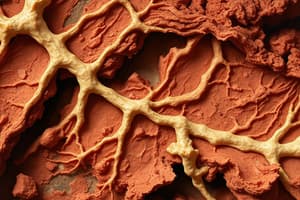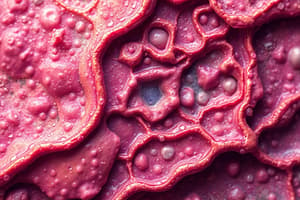Podcast
Questions and Answers
What distinguishes granulocytes from agranulocytes in terms of their structure?
What distinguishes granulocytes from agranulocytes in terms of their structure?
- Granulocytes contain specific granules, whereas agranulocytes contain only primary granules. (correct)
- Granulocytes have a single-lobed nucleus, while agranulocytes have multi-lobed nuclei.
- Granulocytes are larger in size compared to agranulocytes, which are uniformly small.
- Granulocytes lack azurophilic granules, while agranulocytes possess them.
Which leukocyte is primarily responsible for responding to parasitic infections and can contribute to allergic reactions?
Which leukocyte is primarily responsible for responding to parasitic infections and can contribute to allergic reactions?
- Basophils
- Neutrophils
- Eosinophils (correct)
- Monocytes
What feature is common to all types of lymphocytes?
What feature is common to all types of lymphocytes?
- Polymorphonuclear nucleus.
- Production of antibodies.
- Involvement in immune responses. (correct)
- Presence of specific granules.
What is the role of neutrophils in the immune system?
What is the role of neutrophils in the immune system?
What unique characteristic do basophils exhibit in comparison to other leukocytes?
What unique characteristic do basophils exhibit in comparison to other leukocytes?
Which of the following components is NOT found in blood?
Which of the following components is NOT found in blood?
What type of cells are classified as agranulocytes?
What type of cells are classified as agranulocytes?
Where does extramedullary haematopoiesis primarily occur?
Where does extramedullary haematopoiesis primarily occur?
Which characteristic is true for erythrocytes?
Which characteristic is true for erythrocytes?
What is the composition of plasma primarily described as?
What is the composition of plasma primarily described as?
Flashcards are hidden until you start studying
Study Notes
Blood Composition and Characteristics
- Blood is a specialized connective tissue with a fluid matrix.
- Composed of an extracellular matrix (plasma) and formed elements (cells).
- Plasma contains proteins such as albumin, fibrinogen, immunoglobulins, lipids, hormones, vitamins, and salts.
Cellular Components of Blood
- Erythrocytes (Red Blood Cells): Anucleate, biconcave discs approximately 7.8 µm in diameter, lack organelles, and maximize surface area for gas exchange.
- Leukocytes (White Blood Cells): Key in immune responses, migrate out of blood to connective tissues.
- Granulocytes: Neutrophils, eosinophils, basophils; characterized by specific granules in their cytoplasm.
- Agranulocytes: Lymphocytes and monocytes; lack specific granules.
Erythrocytes Function
- Contain hemoglobin, specialized for transporting oxygen and carbon dioxide.
- Diseases impacting RBCs include malaria and sickle cell anemia, affecting oxygen-carrying capacity.
Leukocytes Groups
- Divided into two groups based on granule presence:
- Granulocytes: Includes neutrophils (most common), eosinophils, and basophils, all involved in immune responses.
- Agranulocytes: Comprises lymphocytes and monocytes, playing distinct roles in adaptive and innate immunity.
Granulocyte Characteristics
-
Neutrophils:
- Most abundant, polymorphonuclear with a multi-lobed nucleus.
- Granules include neutrophilic (antimicrobial) and azurophilic (lysosomes).
- First line of defense, motile, and phagocytic.
-
Eosinophils:
- Bi-lobed nucleus, typically 12-15 µm in diameter.
- Associated with allergic reactions and parasitic infections; their granules stain bright red.
-
Basophils:
- Least numerous, with lobed nuclei, 8-12 µm in diameter.
- Contain basophilic granules (heparin) and play a role in hypersensitivity reactions.
Agranulocyte Functions
-
Lymphocytes:
- Vary in size; small lymphocytes are predominant.
- Classified into T cells (cell-mediated immunity) and B cells (antibody production).
- Natural killer cells (NK cells) are part of innate immunity.
-
Monocytes:
- Exhibit rounded or indented nuclei with few lysosomes.
- Differentiate into macrophages and dendritic cells upon leaving blood circulation.
Hematopoiesis Process
- Hematopoiesis occurs in bone marrow and can also take place in extramedullary sites such as the spleen and liver.
- Myeloid stem cells give rise to red blood cells, platelets, and leukocytes.
- Erythropoiesis involves proerythroblasts differentiating into mature erythrocytes.
Immune Responses
- Lymphocytes play distinct roles:
- Innate immunity: NK cells respond to virus-infected cells.
- Adaptive immunity: T and B cells are crucial for specific immune responses.
- Lymphocytes can survive from a few days to several years, depending on their type and activation state.
Studying That Suits You
Use AI to generate personalized quizzes and flashcards to suit your learning preferences.




